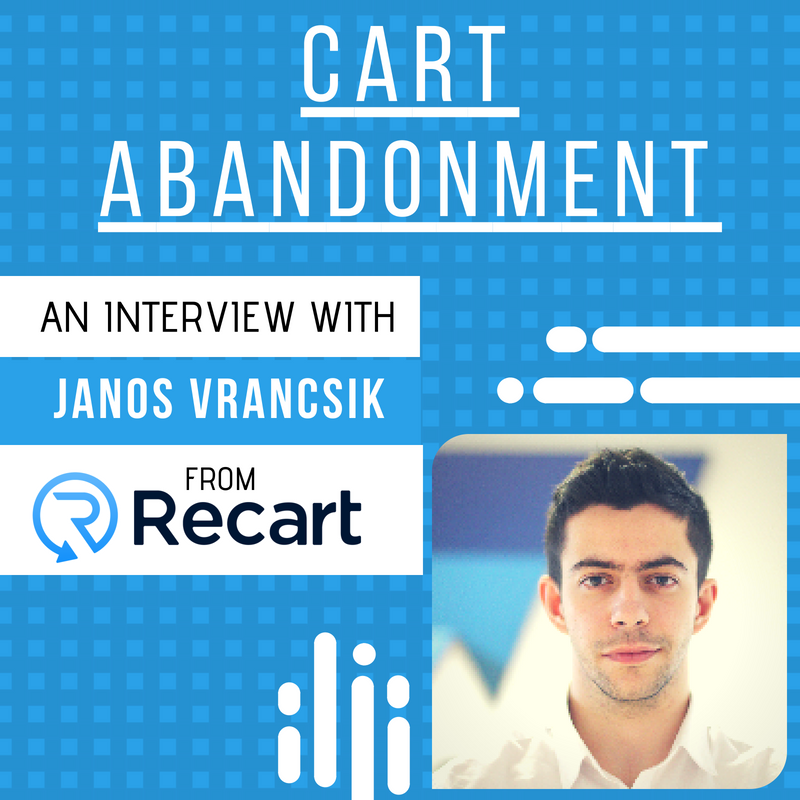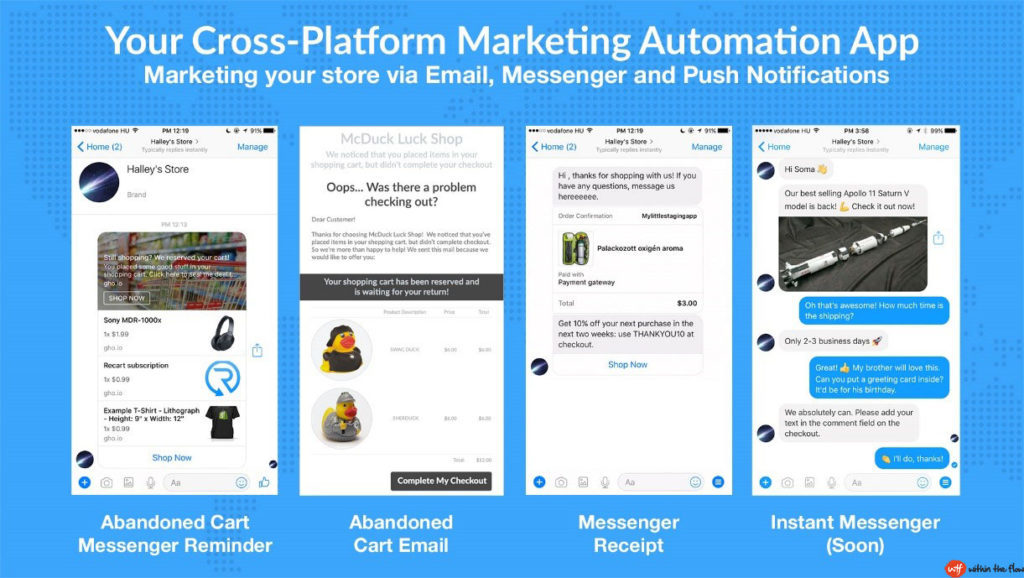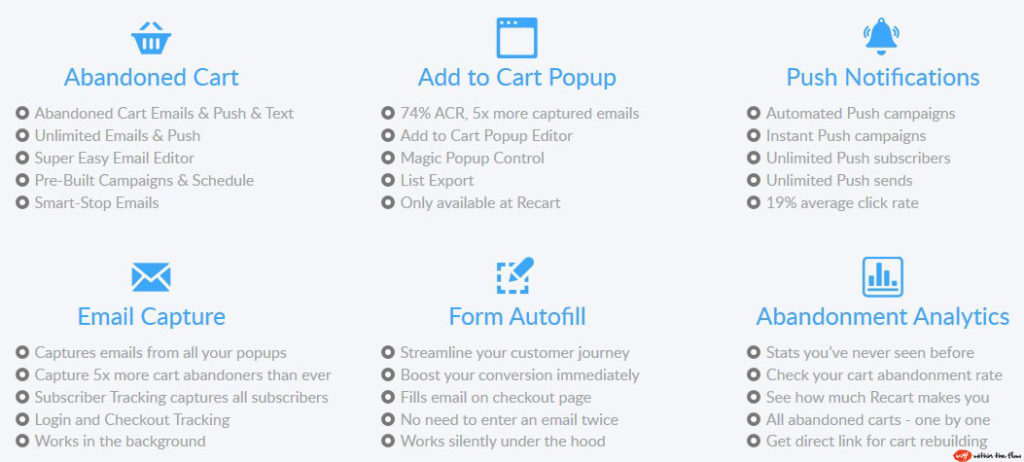Breaking Down Abandoned Cart Recovery with Recart’s Janos Vrancsik
- Jun-06-2018
- Harris Sid
- 0 comments
Abandoned carts are the bane of ecommerce industry. People add TRILLIONS of dollars worth of stuff to their carts before abandoning them every year, making data analysis and decision making a severe headache for e-commerce store owners everywhere.
This is where abandoned cart recovery tools like ReCart help stores get these customers to come back and complete their purchase with the help of tools such as email and messenger automation, push notifications and advanced analytics.
According to their own blog, a whopping 69% of online shopping carts are abandoned on average, 75% of which are due to difficult checkout processes or shipping issues.
I had the pleasure of sitting down to discuss the intricacies of abandoned carts and their recovery with Janos Vrancsik who works his magic on partnerships and integrations at ReCart, a Shopify app that offers abandoned cart recovery solutions. Here’s our Q&A in full:

Harris: First off, for our readers, tell us a bit about yourself, what you do… And how you got started in the e-commerce industry.
Janos: Initially, I started my career in digital marketing, managing email marketing campaigns and building lists for clients. The job gave me great fundamentals and a bit of a technical affinity.
Then I made a step closer to the e-commerce industry when I joined a digital marketing agency, where most of our partners were e-commerce projects in the CEE region. Here, I deep dived into PPC campaign management, and I had the chance to gain significant experience working with online stores.
Then earlier this year, I joined Recart to manage our partnership initiatives and product integrations.
(So if you’re a fellow app developer in the e-commerce space or an agency looking to get in touch with us, feel free to reach out to me!)
Harris: How did the idea for Recart’s Shopify app first come about?
Janos: Recart’s co-founders, Soma and Peter were running several online stores before Recart. They experienced the difficulties of running an e-commerce store and saw the problems thousands of entrepreneurs and companies face every day with cart abandonment, so they decided to create a solution for that.

Since then, we introduced cart abandonment campaigns in email, push and Messenger channels as well. The latter one turned out to be the one that put Recart on the map.
Besides cart abandonment campaigns we developed welcome campaigns as well as many other ways to connect and have a meaningful conversation with customers.
Harris: A lot of abandoned cart recovery solutions these days (email collection, subscriptions, etc.) seem to be at odds with GDPR restrictions. Have any such conflicts come up on your end as an application publisher?
Janos: Of course, many of our users were interested (or even freaked out) about GDPR regulations. Almost every app had at least some work to do to comply with GDPR, I guess. Naturally, it affected us as well, so we’ve implemented a few changes to how we manage our data, but nothing significant.

Facebook and Google were sued to the tune of over $8 billion the day of the GDPR deadline. Some publishers responded to the deadline by making their content inaccessible to Europeans.
Some companies and merchants went to the extreme by completely shutting down their services to EU users, but that’s quite a radical approach I am not a huge fan of.
We’ve seen stores growing their businesses solely on Messenger.
Harris: If every (or maybe half of all) stores out there start using messenger, emails, push notifications and other methods to target every single visitor that left their store without a purchase, do you fear that online shoppers will become desensitized to it all at some point?
Janos: The conversational commerce space is a new one, still in the making. The landscape changes every day. As this space is not as crowded as others (like email marketing), it is easier for merchants to accomplish outstanding results. We’ve seen stores growing their businesses solely on Messenger. As time passes, the trend gets recognized, more and more marketers will jump on the bandwagon. That’s just how it works, and you can’t avoid it. As the space will become more crowded, the people will be used to getting marketing messages on Messenger/WhatsApp/Viber and every other channel they use.
The first (ever) banner ad’s click-through rate was 44%. Now, to measure display ad performance, you have to look at the numbers after the decimal point. As its results are deteriorating, marketing tools all tend to lose some effectiveness.
I genuinely believe that conversational commerce is a significant opportunity for brands and the future of marketing.
As a bottom line, despite that fact that people will probably become desensitized to these forms of messages, I do not doubt that we’ll have other ways to reach them.
Harris: Facebook has gotten a lot of backlash about privacy lately. Do you think people will grow weary of brands marketing to them via Messenger?
Janos: I am not afraid of this. I genuinely believe that conversational commerce is a significant opportunity for brands and the future of marketing. Although I also agree to some extent that at some point it may become too much for some people.
At the same time, we’re working hard to create the Messenger experience convenient and engaging for the visitors. When done right, it is a unique way of connecting them to the brands.
One year in such a fast-paced industry like e-commerce is like spending 3-5 years in any traditional sector. If you stop learning, you’ll miss a lot
When we talk about one channel explicitly, like Messenger, I envision something like a Promotions tab in Gmail, implemented to Messenger.
Harris: What’s the biggest challenge you are facing in your industry today?
Janos: The challenge is the beauty of it as well. As conversational commerce – and especially Messenger Marketing – is still in its infancy, there are no exact boundaries and processes for a lot of things. The principles are just being created. This makes things hard, but fun at the same time. You have to adjust very quickly while building new ways of communicating with customers.
Harris: Lastly, any advice for struggling e-commerce entrepreneurs out there?
Janos: I’ll tell about two tips because I can’t choose between them:
From my own experiences, one of the best advice is always to keep learning. One year in such a fast-paced industry like e-commerce is like spending 3-5 years in any traditional sector. If you stop learning, you’ll miss a lot of notable news/updates/trends, and you’ll fall behind.
You have to develop your habits actively and devote a significant amount of time to learn.
The other one is to run tests and experiments all the time. When you start out, you think you know what works and what doesn’t. While you may have hints, and you may be right, it is just too dangerous to have false assumptions about your customers.
You can’t be sure about how they will respond to specific features. Making decisions backed up by data is the closest you can get. You need to create an environment/mindset/culture for running experiments with ads, descriptions, email copy, etc. Whatever you sell, it takes tests to succeed.
Thank you for your time, Janos.
You can check out ReCart by visiting their website at Recart.com

